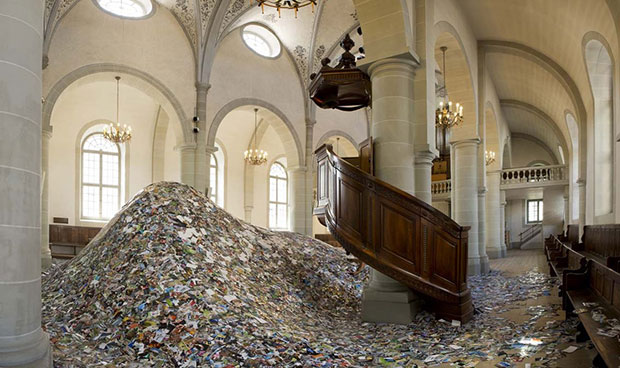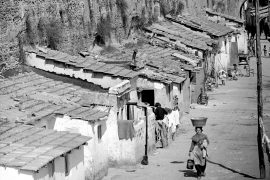by Beatrice Bruni
_
“There is too much gravity, I look for sadness and joy, fun.”
A statement by Erik Kessels, which opens a curious window onto his composite world. Erik Kessels, Dutch artist, but also creative director, curator, designer, collector, gallery owner. A non-author author, who likes to use waste material or photographs taken by others, found in antique markets; in his interventions he gives them new life to suggest his personal definition of photograph, of which the artist particularly emphasizes the excessive use. It is as if he wanted to communicate: we already have too many images, instead of creating new ones, let’s work on those that already exist.
Like Kessels, other authors turn to today’s photography with the same spirit; for example, the works of Michael Wolf, where he uses images from Google Street View, or the experiments of Joachim Schmid, described as “the photographer who does not photograph” and who declared: “No new photographs until the existing ones have been used! “.
There is no doubt that today we are inundated with an overwhelming iconographic tide. In 2016 the social network Instagram received eighty million uploads per day. Not to mention the other social networks, newspapers, books, internet, all the media from which the photographs call us, chase us, attack us.
It is exactly to give the sense of this new coexistence with images, that Erik Kessels creates an extremely significant installation in 2011, entitled 24 Hours in Photos. The artist downloaded and printed, in 10×15 postcard format, all the photographs that had been uploaded on the Flickr image sharing platform over a day. These thousands of prints, 350,000 to be precise, got poured into the halls of the Foam gallery in Amsterdam, creating mountains of images and completely filling any available space. The installation was then taken to many museums around the world.

The intuition behind it is genius: what we would normally only imagine, what has just an abstract texture in our mind becomes tangible, concretely visible and evident. The effect is disruptive: with an intelligent and ironic expedient, Kessels manages to make us experience, in no uncertain terms, the media asphyxia that we are living, he makes it real, present in our physical space in an impressive way.
After a first moment of astonishment and after having experienced the bullying of the sheer quantity of photographs in our lives, what remains? Certainly a reflection on the future of photography, which is the author’s main intent, but also, and perhaps above all, the deeper problem that all this crammed space is the inevitable mirror of the space in our minds.
We can no longer remember all the images we have produced, we forget them, we no longer have the time to look at them all, as every author in the past used to do. This leads to a loss of value of the single image and also to the loss of something much more precious: our memories, our ability to remember. A paradox is created: on the one hand we make our experiences, the places we visit, the important moments of our life, our cultural projects available to anyone, and even the most intimate event becomes shared property; on the other hand, all of this loses its meaning, the profound uniqueness that every family, travel, landscape or authorial image had in the past is lost.
The acquisition of corporeality by virtual images makes evident what is an issue that should not be underestimated: one of the primary functions of photography, the one that identifies it as a keeper of memories, as an object that holds back what is real now and isn’t any more immediately after, is failing, since our memory is buried under huge piles of fading images.
March 6, 2019




